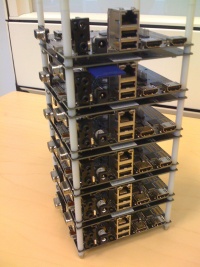< Architectures | ARM | Fedora 18 Alpha
Pandaboard
The Pandaboard is one of the most popular ARM devices available and provides users with either a desktop environment or minimal installation (text based).
Technical Specifications
- 1 GHz Dual core Cortex A9 Processor (OMAP 4430-4460)
- 1 GB DDR2 RAM
- HDMI v1.3
- 10/100Mbit/s Ethernet
- 802.11 b/g/n WiFi
For more information on the Pandaboard visit their website.
Running Fedora on a Pandaboard
This page will give you detailed instructions for running Fedora 18 Alpha on your Pandaboard. The provided image will provide both serial and the XFCE desktop.
Download the image
The first step is to download the Fedora 18 Alpha image. The prebuilt image includes everything you will need to boot your system and will require a minimum of 4GB for the root filesystem
Writing the Image
You can write the image to an SD card of your choosing but it does have to meet the minimum size requirements of 2GB. You can optionally use a USB device for the root file system to improve performance. For use with SD:
xzcat Fedora-18-Alpha-armhfp-panda-xfce.img.xz > /dev/<path-to-SD-device>
For use with SD/USB
xzcat Fedora-18-Alpha-armhfp-panda-xfce.img.xz > /dev/<path-to-SD-device> xzcat Fedora-18-Alpha-armhfp-panda-xfce.img.xz > /dev/<path-to-USB-device>
Then use fdisk to delete the boot partition from the USB attached media, and rootfs and swap partitions from the SD card.
fdisk /dev/<path-to-SD-device>
Delete partitions two and three (d,3,d,2,w).
fdisk /dev/<path-to-USB-device>
Delete the first parition only. (d,1,w)
Once completed run the below command to ensure the entire image is written to the card:
sync
Windows Users
- You will need to download Win32 Image Writer as well as a tool to extract the image such as 7-Zip.
- Once downloaded and installed right click on the disk image and select "7-Zip->Extract files here"
- Launch Win 32 Disk Imager and select the extracted disk image and the SD card you would like to write the files to. Click "Write". Be very careful during this step - all data on the selected drive will be lost!
Using Fedora on the Pandaboard
Connect the newly created media to your Pandaboard and power on. No further steps are required and your system should boot to a text based log in prompt (serial image) or to a graphical log in (XFCE Desktop image). The default root password is "fedoraarm". This should be changed immediately.
Known Issues
- Yum requires the system time be correct for HTTPS to function. If yum updates are not working check your clock.
- The tar.xz rootfs archives do not preserve SELinux information or file capabilities. If you use these to create your own filesystem image it is recommended that you switch SELinux to use warnings instead of enforcing for first boot, then relabel and reinstall packages that rely upon filesystem capabilities such as glibc-common and ping.
- Images are designed to be written to 2GB (console) or 4GB (xfce) SD cards. On first boot the partition will be resized to the maximum allowable amount. On the second boot the filesystem will be resized to fill the expanded partition. This works for SD cards, SATA Disks, and SSD drives.
- The XFCE Desktop image uses the HDMI port for display, which will work as a dvi-d also.
- The powerVR gpu is currently not available in the omapdrm driver used in Fedora kernel-omap.
- Each time the panda boots a new random MAC address is generated. This is because there is no EEPROM to store the mac address. To have the same eth0 MAC address after reboot the /etc/sysconfig/network-scripts/ifcfg-eth0 file needs to have MACADDR= line added.
- Known release issues
Additional Support
There are Fedora ARM users all around the globe - if you need assistance, would like to provide feedback or contribute to Fedora ARM please visit us on the IRC - we can be found in #fedora-arm on Freenode. You can also contact us on the mailing list - arm@lists.fedoraproject.org

